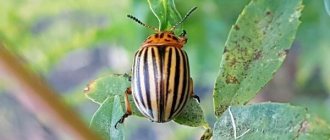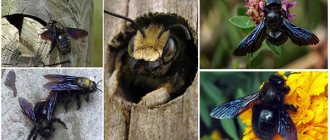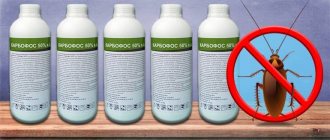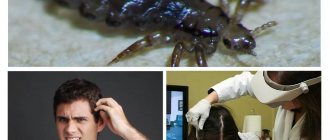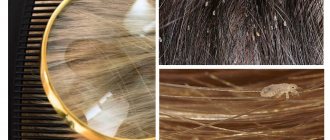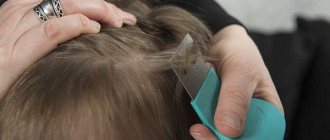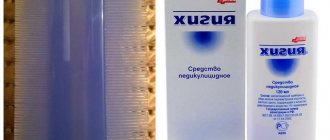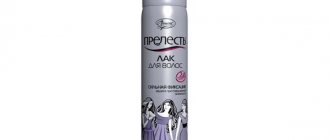Pediculosis is a parasitic infestation that most often affects children, as well as people who lead an asocial lifestyle and neglect personal hygiene.
What to do in such a situation? To get started, we recommend reading this article.
This article describes in detail methods of controlling parasites. We also recommend that you consult a specialist. Read the article >>> Lice do not lead to serious illnesses, but they do cause aesthetic inconvenience. In addition, arthropods are transmitted very quickly from person to person. Therefore, the disease should be treated at the first appearance of pediculosis. For this purpose, doctors have developed many measures to combat parasites, these include anti-pediculosis styling.
What is anti-pediculosis styling and where should it be located?
All specialized institutions for children and medical organizations that receive patients on an outpatient or inpatient basis must have a first aid kit, which must necessarily include pediculocidal agents and anti-pediculosis styling.
Pediculosis should be combated comprehensively. It is necessary to treat both the infected person and his belongings, as well as his home. For this purpose, there is anti-pediculosis styling in sanitation.
Anti-pediculosis styling is a set of medications and things intended for treating patients.
Order on pediculosis 342: anti-pediculosis styling, composition
Pediculosis is a disease caused by parasites such as body louse, head louse, and pubic louse. They are also carriers of typhus, relapsing fever, and Volyn fever. Those infected feel itching, a rash appears on their skin, rough areas appear, and pigmentation changes. In advanced stages, tangles form in the hair, an increased body temperature is observed, and the lymph nodes become enlarged. The seriousness of this disease is added by the high level of infection among the population: after all, only the clothes of the sick person will be a source of infection for another 3 months.
Composition - what is included in the contents of anti-pediculosis styling?
Anti-pediculosis styling consists of:
- oilcloth bag for the patient's belongings;
- a galvanized tray intended for destruction or disinfection of hair;
- oilcloth cut for manipulation;
- rubber gloves;
- scissors;
- thick metal comb;
- hair cutting equipment;
- alcohol lamps;
- 2 polyethylene caps;
- cotton wool;
- towels;
- table vinegar;
- means for killing lice (“Boric ointment”, “Fenotrin”, etc.);
- preparations for treating premises (Dichlorvos, Pyrethrin, etc.)
- shampoo;
- disposable robe.
Important! The anti-pediculosis styling should include instructions for using the kit.
Classic and modern composition, are there any differences?
The modern composition of anti-pediculosis styling differs from the classic one. What should include:
- yellow package marked “B”;
- protective overalls and respirator mask;
- shoe covers.
The composition should contain several means to combat parasites on the human body and 1 or 2 drugs for disinfecting premises.
Are there any differences in treatment with pediculocidal agents for medical personnel, patients, in hospitals, hospitals, emergency rooms, kindergartens and schools.
Remedies for head lice
The main substances for killing insects are ovicides (emulsions, shampoos, lotions) for one-time treatment and neocides (shampoos, soaps, etc.) for two-time treatment.
To combat parasites, products such as vinegar, pyrethrum powder, tar soap, and various lotions, such as Nittifor, are used.
The list of preparations intended for disinfestation of things includes soap-kerosene emulsion, concentrates of karbofos, sulfidos, sodium carbonate and others.
Anti-pediculosis measures are carried out in accordance with Order No. 342
Summary of Order of the Ministry of Health No. 342
Order of the Ministry of Health No. 342 talks about the composition of anti-pediculosis styling, the rules for its use and the prevention of head lice.
- To carry out the styling, the person performing it should wear a robe, a protective scarf and gloves;
- Wrap the patient in oilcloth, paying special attention to eye protection;
- Treat the patient’s hair with a special product and cover the head with a cap;
- After treatment, the hair is washed with running water;
- After this, the head should be washed with a specialized shampoo;
- Next, dry your hair and comb each strand with a comb to remove any remaining lice;
- At the end, a final examination of the patient and processing of the materials used are carried out.
Order of the Ministry of Health No. 342
Thus, seemingly harmless lice is a socially dangerous disease that can quickly develop into an epidemic. We should not forget about the danger that the disease disrupts the harmonious functioning of the circulatory and nervous systems. If a pulmonary thrombus forms, it can be fatal.
Order No. 342 on pediculosis (anti-pediculosis styling is one of its constituent points) was adopted by the Ministry of Health of the Russian Federation in 1998. Its action is aimed at a comprehensive fight against the pathogens of pediculosis and typhus epidemics. It contains the following components:
- Prevention of typhus.
- Treatment of lice.
- Fighting pathogens.
- Measures to improve the epidemiological situation, sanitary and hygienic conditions in public institutions.
Let's look at anti-pediculosis styling in detail, an order for pediculosis.
Prevention of head lice
Any disease is easier to prevent than to treat. This expression is also true for pediculosis, because infestation with lice can lead to the development of pyoderma and typhus. Prevention of head lice involves the use of special medications and products.
Prevention of head lice can be divided into: passive and active. The main preventive measures are:
- Avoid contact with people living in unsanitary conditions;
- Lead a decent sex life, avoid casual relationships;
- Use personal hygiene products. These include: toothbrush, clothes, shoes, comb, elastic band, hairpin, hat.
- Wash clothes and bedding regularly;
- Carry out periodic checks for the presence of nits in the hair;
- Use special repellents and preventive shampoos. Hellebore water or lavender tincture reduces the likelihood of lice if you periodically drip it on the head and behind the ears.
There are medications aimed at preventing head lice. They are available in the form of shampoos, lotions and sprays. These products contain insecticides that kill lice.
Important! Insecticide-based preparations are toxic and should not be used by children.
Insecticidal agents prescribed for the treatment and prevention of head lice include:
Shampoos
- "Parasidosis" is recommended for use by adults and children over 5 years of age.
- "Pedilin" is used to prevent the disease in adults and children over 2 years of age. But the drug can cause allergies, so it is not suitable for allergic children.
Shampoos for prevention should be used 1-2 times a week.
Sprays
- RoshTov is recommended for children over one year of age. Created on the basis of essential oils and plant extracts.
- "LysGuard" is used to treat the head, clothing and hats.
The effect of the sprays lasts throughout the day, so it is advisable to apply them to your hair before leaving the house.
New SanPiN for the prevention of pediculosis - No weeds
Application for goods
| Price 4500 rubles Pediculosis styling is intended for anti-pediculosis treatments. It includes a set of necessary things and preparations necessary for identifying and destroying lice. Scope of application of styling with pediculocidal agents: - medical offices of educational institutions, including school and preschool age - children's homes and boarding schools - hospitals, clinics - sanatoriums , children's camps - social services |
New SanPiN for the prevention of pediculosis
The new SanPiN for pediculosis 2021 defines the rules, the procedure for preventive measures, and the algorithm for treatment for pediculosis. The same document lists the rules for the prevention of scabies, the abdominal type, which is spread by lice. The joint venture on typhus and pediculosis and scabies is mandatory throughout the Russian Federation.
Basic provisions
The news about changes in legislation on the prevention of lice instantly spread throughout Russia. The order is to immediately familiarize yourself with it in order to know what to do in a given situation. Sanitary rules for head lice describe the actions that health workers must take to prevent epidemics of the disease and prevent:
- preventive examinations of the population are carried out according to a plan approved and agreed upon by higher authorities;
- all preschool educational institutions, kindergartens, orphanages, sanatoriums, rest homes, inpatient organizations, the purpose of which is to ensure the maintenance of child health, are provided with washing, disinfestation, and personal hygiene products;
- first-aid posts and other organizations that treat pediculosis, disinfestation of premises and things, and provide special equipment, machinery, and supplies;
SanPiN for pediculosis is mandatory, the requirements of the new version of the law are taken into account.
Signs of infection
The causative agents of the infection are several types of lice:
Parasites feed on human blood, are capable of spreading typhoid fever, and pose a threat to the entire society. The main symptoms of different types of pediculosis are similar to each other, only the location of the parasites differs.
- Head lice parasitize the scalp, live in the scalp, eggs cling to the hairs closer to the roots; you can see what lice and nits look like in the photo.
- Body lice live outside the human body, building nests in folds, seams of clothing, and bedding. They feed about 4 times a day, so they are often found on the human body. Linen lice bites are located on the body and face. They do not live on the head or genitals.
- Pubic lice are most often transmitted through sexual contact. Affects the pubic hair and perineum. With severe infection, parasites are found on the hair of the abdomen, chest, armpits, and eyelashes.
- severe itching caused by lice bites;
- change in skin color, appearance of spots, rashes;
- scratching on the skin;
- ulcers, wounds, inflamed scratches indicate the addition of a secondary infection;
- roughened areas of the epidermis;
- hair matted with pus and constant itching.
The order on pediculosis obliges medical workers to conduct routine examinations and take measures to eliminate lice.
Inspection procedure
Routine head examination
It is carried out in a well-lit place with basic tools. A comb or fine-toothed comb, a magnifying glass or a magnifying glass is required.
- Inspection for lice in kindergarten according to SanPiN is carried out every month. The medical worker carefully examines each child or conducts a random examination. The examination results are recorded in a special journal.
- Pediculosis at school is a common occurrence. Routine inspections are carried out 4 times a year. The frequency of preventive measures in schools is the same. It is mandatory for a nurse to examine students before the new school year and after the holidays.
- Children who go on holiday to a health camp or holiday home are examined before departure for the absence of parasitic diseases.
- Patients are examined at the sanitary inspection station before being assigned to inpatient treatment. A visit is made to the address where the patient should live, in accordance with the legislation in Russia.
- In organizations, employees undergo a routine examination once a year.
Responsibility for conducting preventive examinations rests with the medical professional. The results are entered into a special form and a number is entered.
Pediculosis in preschool and school institutions
Children who have been diagnosed with lice are prohibited from attending kindergarten or school. Immediately after lice are discovered, the child is isolated. The teacher, class teacher, and administration of the institution are notified about the situation. Parents are informed.
A medical professional must advise parents about how to quickly get rid of lice. Treatment is carried out at your own expense. Visiting an educational institution is allowed after full recovery, with the provision of a supporting certificate.
If several infected children are found in a class or group, quarantine is declared. Maximum duration 30 days. During this time, a complete disinsection of the premises, beds, furniture, bedding is carried out, and prevention of re-infection is carried out. The SES can extend the quarantine period.
Parents have the right to write a complaint to the state sanitary and epidemiological service if the management of the institution or organization does not respond to the problem properly.
Fighting methods
Control of parasites
According to the new SanPiN, treatment of head lice and methods of control depend on the type of disease.
- At the initial stage of head lice, you can get rid of parasites mechanically. Comb nits out of hair strand by strand with a special comb with long, frequent teeth.
- With linen lice, items, clothing, and bedding are subject to mandatory thermal and chemical treatment. Wash at temperatures above 60 degrees Celsius for half an hour, or boil for 5 minutes. Iron with steam, paying special attention to folds, seams, and pockets.
- Pediculosis pubis is the easiest to eliminate. Hairs on the pubic area, groin, genitals, and anus are shaved. Treated with a disinfectant. Clothes, underwear, bedding, and towels are washed at high temperatures.
The chemical control method involves the use of preparations containing insecticides. The substances disrupt the functioning of the nervous system, causing paralysis and early death. It is allowed to treat the head, things, clothes, and premises with special pediculicidal preparations.
To combat head lice, use shampoo, spray, ointment, solution, emulsion, cream. They recommend Nuda, Nittifor, Para Plus, Nyx, Paranit, and benzyl benzoate emulsion. You can choose a remedy at your own discretion, taking into account the age of the child and the individual characteristics of the body.
For any type of head lice, the premises must be disinfested using chemical insecticides.
Lice prevention
Prevention of pediculosis consists of conducting explanatory work among the management of organizations, teachers, and educators. Parents are required to monitor the child’s condition and check their head every week. If pediculosis is detected, take emergency measures to cure it. Necessary for prevention:
- use your own personal hygiene items, towels;
- It is prohibited to exchange clothes, combs, and hats;
- Be sure to wash your body every week;
- hygiene procedures every evening;
- change of bedding twice a month;
- Contamination on clothing in public places is not allowed, according to the law;
- regular hair cutting, neat, neat hairstyle;
- cleaning the house for prevention using disinfectants containing bleach or adding vinegar.
Basic rules of hygiene and behavior in public places will protect against infection and stop the outbreak of the disease.
Instructions on carrying out preventive measures are sent to each organization, educational institution, and enterprise. According to the resolution, every new employee and child must be examined for preventive purposes before being introduced into the team.
Contents of anti-pediculosis styling
1. An oilcloth or cotton bag for collecting the patient’s belongings.
2. Galvanized bucket or tray for burning or disinfecting hair.
3. Oilcloth drape.
4. Rubber gloves.
6. A fine-toothed comb (preferably metal).
7. Hair clipper.
9. Headscarves (2 - 3 pieces).
12. Means for the destruction of head, pubic, body lice and disinfestation of premises.
The sequence of actions of a nurse when identifying pediculosis
Equipment: robe, waterproof apron, gloves, oilcloth, towel, comb, anti-pediculicide.
I. Preparation for the procedure
1. Wear an additional robe, apron, and gloves.
2. Explain to the patient the need and sequence of the upcoming procedure and obtain consent to perform it.
3. Sit the patient (if condition allows) on a chair covered with oilcloth (or lay oilcloth on the floor and place a chair on it).
4. Give the patient (if possible) a towel to protect his eyes from getting the pediculicide. If the patient is unable to hold a towel, an assistant will do this for him, who should also have an additional gown and gloves.
II. Executing the procedure
5. Treat the patient's hair with any anti-pediculicide.
6. Cover the patient’s hair with a cap for 20 minutes (some technologies do not require a cap)
7. Rinse your hair with warm water and dry it.
III. Completing the procedure
9. Place the patient’s linen and clothing in bags for disinfestation.
10. Remove gloves, apron, robe (place in a bag for disinfestation), wash your hands.
11. On the title page of the “Inpatient Medical Card”, make a note about the identified pediculosis: “P” (Latin pediculus - louse).
12. Fill out an emergency notification about the detection of an infectious disease and report it to the sanitary and epidemiological inspection institution (form No. 058u).
13. Examine the patient's dry hair.
After disinfestation of the patient, the room and objects with which
he came into contact, it is necessary to treat with the same pediculicidal drugs. The comb is doused with boiling water after each inspection, or wiped with a 70-degree alcohol solution.
Didn't find what you were looking for? Use the search:
37.252.1.220 © studopedia.ru Not the author of the materials posted. But it provides the opportunity to use it for free. Is there a copyright violation? Write to us
Source: https://sorniakam-net.ru/novyj-sanpin-po-profilaktike-pedikuleza.html
How to check for lice and nits
Examination of the scalp when identifying lice is the best prevention of the spread of the disease. A routine examination allows you to identify the disease in the early stages of its development and spread.
A person is tested if they exhibit the following symptoms:
- nits or live lice appeared on the head;
- the scalp itches, mainly at night;
- there are bite marks behind the ears and on the back of the head;
- pustules appeared on the scalp.
The scalp is checked using a special comb with frequent and long teeth.
Fighting methods
Control of parasites
According to the new SanPiN, treatment of head lice and methods of control depend on the type of disease.
- At the initial stage of head lice, you can get rid of parasites mechanically. Comb nits out of hair strand by strand with a special comb with long, frequent teeth.
- With linen lice, items, clothing, and bedding are subject to mandatory thermal and chemical treatment. Wash at temperatures above 60 degrees Celsius for half an hour, or boil for 5 minutes. Iron with steam, paying special attention to folds, seams, and pockets.
- Pediculosis pubis is the easiest to eliminate. Hairs on the pubic area, groin, genitals, and anus are shaved. Treated with a disinfectant. Clothes, underwear, bedding, and towels are washed at high temperatures.
Modern and effective remedies against pediculosis
In pharmacies you can find various medications against pediculosis. Depending on the causes of lice and the area of infestation, different forms of medications may be prescribed.
In some cases, shampoos and sprays will be more effective, in others - ointments, tablets, concentrates and aerosols.
The differences in the use of the products are insignificant, therefore they are most often produced complete with a comb. The cream should be applied to damp hair, the spray on dry hair, and the hair should be washed with shampoo.
Shampoos
When infected with lice, the following shampoos are effective:
- Veda. The shampoo contains an insecticide - permethrin, which kills head and pubic lice approximately 30 minutes after application.
- Paranit. The main component is clearol mineral oil. This substance covers the lice like a film and they die.
Sprays and aerosols
The drugs are effective at the initial stage of the lesion.
- Nyuda. The spray contains an insecticide - dimethicone, which causes asphyxia of parasites, which leads to their death.
- A-Par. An aerosol that needs to be used to treat the patient’s personal belongings. The drug is effective in the fight against body lice.
Ointments and creams
Creams and ointments are the cheapest means to combat lice. They are much more difficult to apply, but the effect of application is visible almost immediately.
- Nittifor. The cream contains permethrin, which acts on both lice and their larvae. Not recommended for use by children under 5 years of age.
- Benzyl benzoate. The ointment is used only in medical institutions, as it is toxic.
Concentrates and lotions
It is believed that these drugs are the most effective in the fight against lice, as they are insecticidal solutions. The action of the products is aimed at blocking the nervous system of lice. Which leads to their instant death.
- Medifox. Alcohol solution based on permethrin. To use it, it should be diluted with water.
- Foxylon. A lotion whose active ingredient is 20 percent benzyl benzoate. The active substance destroys parasites in 10 minutes.
Treatment of pediculosis must be agreed with the attending physician, otherwise it can provoke the development of an allergic reaction. Anti-pediculosis styling allows you to get rid of all types of lice. It should be located in any medical and educational institutions.
Sanitary treatment of the patient when identifying pediculosis
The Ministry of Health of the Russian Federation issued Order No. 342 on November 26, 1998. The goal is to stop the spread of head lice and infectious diseases carried by lice.
The female lays 4 eggs per day. The louse lives up to 38 days and is sensitive to temperature. Outside the host's body, it dies within 1 day. At temperatures below 20 °C, egg laying stops and larval development stops.
Typhus or rickettsiosis is a severe infectious disease in which destructive changes in blood vessels and the development of generalized thrombovasculitis occur. Symptoms of this disease are:
- fever and temperature;
- intoxication of the body;
- roseola-petechial rash.
The first 2 species are carriers of infectious agents such as typhus, relapsing fever, and Volyn fever. The greatest danger in the event of epidemics are body lice, which, after consuming the blood of a patient, can become carriers within 5-7 days and transmit the infection to healthy people.
Treatment algorithm for pediculosis:
- Prepare a solution to kill parasites in accordance with the instructions.
- Consistently treat hair against lice, avoiding contact of the product with mucous membranes and face. Each strand should be processed separately.
- If your hair is long, put it in a bun and cover it with a plastic scarf.
- Maintain exposure according to the drug manufacturer's recommendations.
- After the specified time has passed, rinse off the product with warm water, after removing any remaining product, wash your hair with detergent shampoo and rinse with vinegar solution.
- After applying the vinegar solution, tie your hair with a plastic scarf and leave it in this state for 15-20 minutes.
- Rinse your hair again with warm water and dry with a towel.
- Place the patient on a chair and place paper on the floor to make it easier to dispose of insects later. Be sure to comb out dead insects and nits using a fine-tooth comb.
- Periodically remove adhering parasites from the comb using a cotton swab soaked in alcohol.
- At the end of the procedure, re-examine the patient and make sure there are no lice and nits.
- If necessary, re-treatment of hair for pediculosis is prescribed.
The following products are effective in styling:
The fight against lice requires an integrated approach. Not only the patient himself and his belongings are subjected to treatment, but also his place of residence.
It is possible to defeat parasites!
Antiparasitic Complex® - Reliable and safe removal of parasites in 21 days!
- The composition includes only natural ingredients;
- Does not cause side effects;
- Absolutely safe;
- Protects the liver, heart, lungs, stomach, skin from parasites;
- Removes waste products of parasites from the body.
- Effectively destroys most types of helminths in 21 days.
There is now a preferential program for free packaging. Read expert opinion.
Interesting to know:

